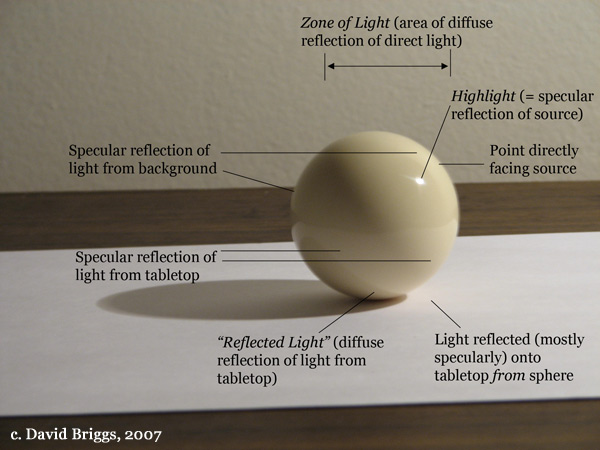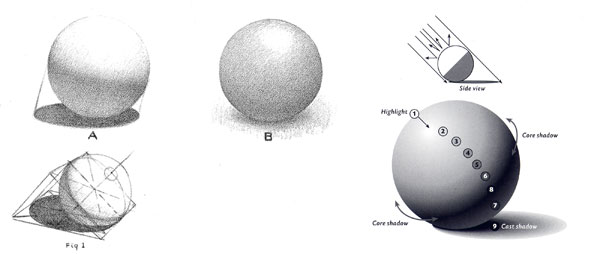my colour short course is
now offered online through
Australia's National Art
School in Sydney! There's
a choice of two sessions to
suit every time zone. LINK
Home
The Dimensions of Colour
Basics of Light and Shade
Additive Mixing
Subtractive Mixing
Mixing of Paints
Hue
Lightness and Chroma
Brightness and Saturation
Principles of Colour
Afterthoughts
Glossary
References
Contact
Links
NEXT COLOUR
WORKSHOPS

Part 2. BASICS OF LIGHT AND SHADE
SPECULAR AND DIFFUSE REFLECTION

Figure 2.1. Glossy sphere (billiard ball) under a single direct light source, showing effects of specular and diffuse reflection. Photograph by David Briggs.
Light is reflected from most surfaces by two simultaneous processes, known as specular (or surface) reflection and diffuse (or body) reflection. Specular (literally "mirror-like") reflection creates the highlight as its most conspicuous expression (Figure 2.1). On our ball, as on most substances apart from the coloured metals like copper and gold, the specular reflection retains the colour of the (white) light source. The diffuse reflection is seen as the local colour of the surface (in this case, off-white).
In specular reflection, light bounces according to the rule that the angle of incidence (measured against a line perpendicular to the surface) equals the angle of reflection. On any shiny object we see the highlight, or specular reflection of the light source, at the point where the surface is at just the angle needed to bounce light from the light source to our eye in accordance with this rule (Figure 2.2). Consequently the apparent position of the reflection varies with the location of the observer, and even between the two eyes of the observer. On polished objects our stereoscopic vision traces the two rays to our eyes back to an illusory or virtual image that appears to be located, as in a mirror, below the reflecting surface. Polished objects may show not only the conspicuous image of the main light source, but also recognizable reflections of the entire environment. Less polished surfaces show a relatively "fuzzy" highlight, as the specular reflection is spread over an area in which some microfacets lie at the critical angle.

Figure 2.2. Position of highlight. Light bounces to the viewer's eye at the point on the surface where the angle of incidence equals the angle of reflection, and the viewer sees the highlight along this line. The viewer can not possibly see the highlight at the point facing the light source; the light ray hitting the surface at this point bounces straight back to the light source.
Many art instruction texts erroneously show the position of the highlight at the point directly facing the light source (Figure 2.3). In fact, the light ray incident at this point hits the surface at a right angle, and bounces straight back to the light source, not to the observer. Only in the case of a light source in the same direction as the observer does the highlight fall at the point facing the light source. On a sphere the highlight is always seen somewhere on the line between the point facing the light source and the visual centre of the sphere.

Figure 2.3. Diagrams of light zones on a sphere from two popular art instruction texts. Left from Loomis (1951), and right from Aristides (2007). Both works show the highlight (incorrectly) at the centre of the full light, facing the light source. As seems conventional in this sort of diagram, the diffuse reflection of light from the tabletop is shown but not the specular reflection, and a continuous band of core shadow is shown alongside the terminator. The actual appearance of a sphere in this lighting may be quite different (e.g. Figure 2.1).
The diffuse reflection consists of light that does not (macroscopically) obey the rule of angle of incidence equals angle of reflection, but instead is reflected equally in all directions. Several "popular science" internet sites currently perpetuate the error that specular and diffuse reflection result from surfaces being polished or rough respectively (e.g. Molecular Expressions). Actually, diffuse and specular reflection operate simultaneously from most materials, and evidently by quite distinct processes, in that the specular reflection typically retains the colour of the light source, while the diffuse reflection is often coloured by the material. Diffuse reflection is considered to result from subsurface scattering; that is, light enters a surface layer, is scattered multiple times, and then exits in a random direction (Hanrahan and Kruger, 1993). The exact proportion of the two kinds of reflection depends essentially on the type of material (metals exhibit high specular and no diffuse reflection), and on the angle of incidence (light striking at a low angle to a surface is more likely to be reflected specularly), but not on the roughness of the surface. Polishing a rough surface will make a "fuzzy" specular reflection more concentrated by reducing variation in microfacet orientation, but will not necessarily increase the total amount of specular reflection unless it involves removal of a diffuse-reflecting coating.
Subsurface scattering in some materials is extensive enough to cause visible subsurface light transport, resulting in macroscopic translucency. In some current literature on rendering in 3D programmes, the term "subsurface scattering" is restricted to such materials (milk, marble, etc.). Many other materials permit enough subsurface scattering to create a diffuse reflection, but look opaque at a macroscopic level, and only reveal their translucency in thin section. Materials that are opaque even on a microscopic scale have no diffuse reflection, and appear either black, sub metallic (e.g. graphite) or metallic, depending on the amount of specular reflection they exhibit.
The amount of specular reflection generally appears to be greater on dark objects than on white objects of similar composition, but this is an illusion caused by swamping of the specular reflection by the greater diffuse reflection from the latter.
Away from the highlight, specular reflection of light from the environment occurs over the entire surface. This addition of specularly reflected light, retaining as it does the colour of the environment, has the effect of desaturating the colour of light reflected by coloured objects. In general these specular reflections are most conspicuous in the shadow zone, where they are not swamped by diffuse reflection, and on the receding planes, where the specular reflection, being created by light from behind the object hitting the surface at a low angle, is more intense. The tendency to relatively strong specular reflection on the receding planes may be quite noticeable even in fully lit areas however, especially if there are light-toned objects in the background.
